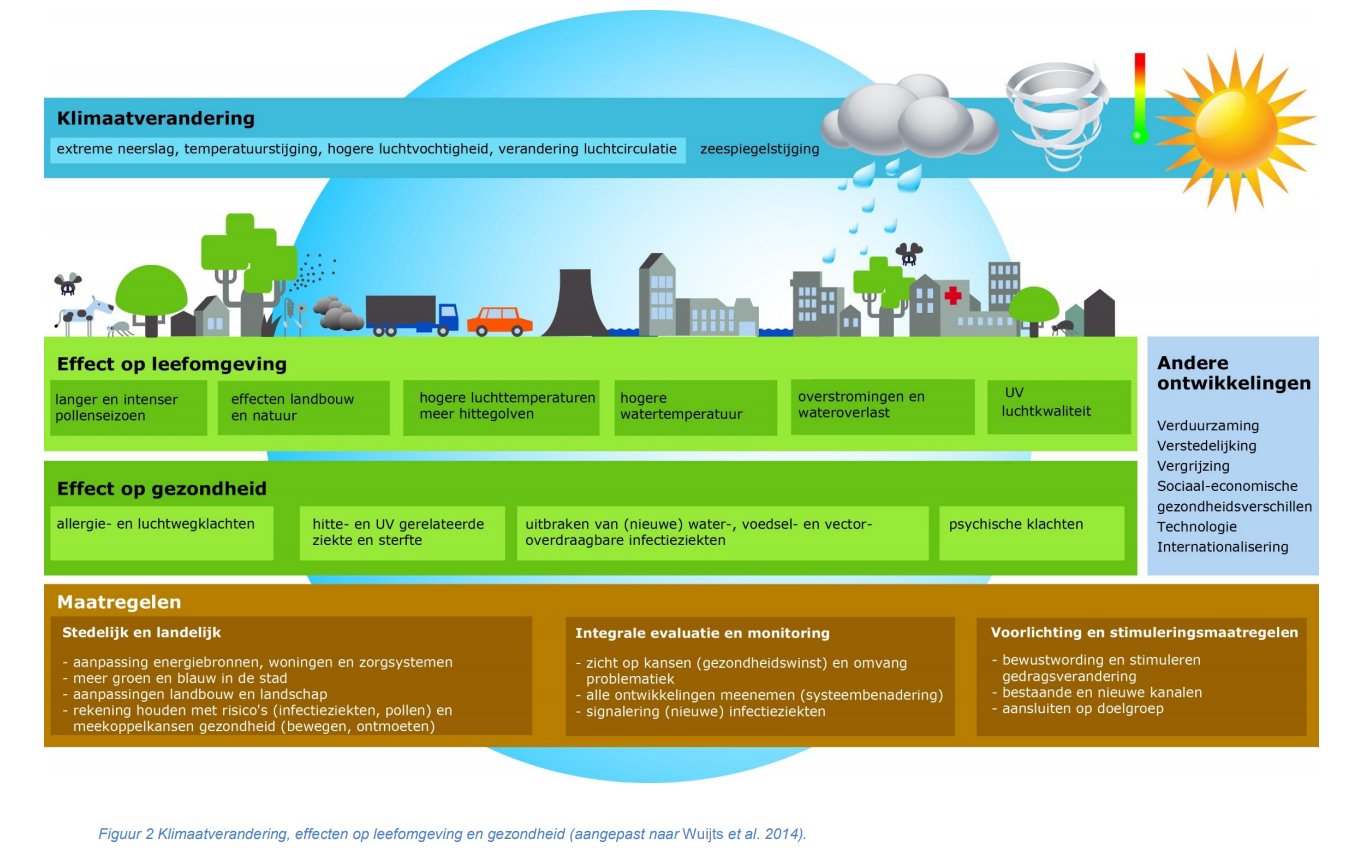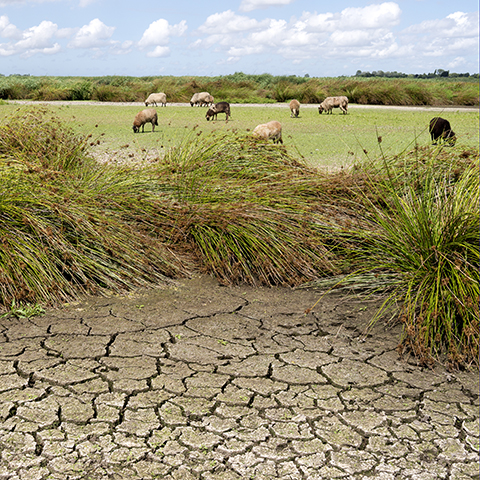Afbeelding
What is climate change?
The Earth's climate is changing. It always has, but never so fast. The average temperature on earth has been rising for the past 100 years. This is because there are more and more greenhouse gases in the air.
The greenhouse gas CO2 is responsible for most of the temperature increase. CO2 is mainly released when burning fossil fuels such as oil, coal and gas. Climate change also means extreme amounts of precipitation and drought. But it also means a change in wind currents and a rise in the sea level.
These consequences are already noticeable in our environment. In the Netherlands, for example, we are seeing more warm days, more heat waves and extreme rainfall. KNMI has been monitoring temperatures since 1901. There have been 28 heat waves since 1901. 12 of these have occurred in the past 20 years. It also appears that heavy rainfall is becoming more frequent and the average annual temperature is increasing.
The summer of 2019 was a record summer. It never got so hot during the day, namely 40.7°C. Such temperatures may become more frequent in the future.
blok1
How does a changing climate affect health?
Climate change has an impact on health. In 2019 there was a long heat wave. During that period, 400 more people died than during a normal summer, according to the RIVM. This was most likely due to the long period of heat. Especially people over 75 died because of the heat. People go outside more often when the weather is nice. This is also reflected in the number of cases of skin cancer (type of melanoma). There is a clear increase in the number of melanoma cases. This can be explained by the increase in the number of hours people spend in the sun.
The picture on the right gives a summary of how climate change affects the living environment and people's health.
Afbeelding
Effects of climate change on environment and people
Climate change affects our living environment. For instance, the growing season of plants and trees is changing. This leads to a longer and more intense pollen season. People with hay fever suffer more as a result. Agriculture and nature have to deal with periods when it rains more or is dry longer.
Air and water temperatures will rise in our surroundings. We may also have to deal with flooding from the rivers/sea and inundation due to heavy rain. More particulate matter and UV radiation will worsen the air quality. This can lead to an increased risk of allergy and respiratory complaints. Heat can lead to heat stress, dehydration and mental complaints.
Higher temperatures cause bacteria to grow faster in water used for swimming in summer. This increases the chance of getting sick after swimming due to, for example, blue-green algae.
Not all effects of climate change are negative for health. Warmer winters mean fewer deaths. Higher (annual) temperatures mean that we go outside more. We exercise and relax more in the open air.
Afbeelding
Het weer van de toekomst
Het IPCC is het Intergovernmental Panel on Climate Change en bestaat uit wetenschappers uit de hele wereld. Zij vatten het recente onderzoeken naar klimaatverandering samen en maken scenario’s. Scenario’s zijn toekomstbeelden – ze laten zien wat de wereld mogelijk te wachten staat. Het KNMI vertaalt het onderzoek van het IPCC naar de Nederlandse situatie.
In oktober 2023 kwamen de nieuwe KNMI-klimaatscenario’s uit. De scenario’s helpen om beslissingen te nemen, bijvoorbeeld waar we veilig huizen kunnen bouwen en hoeveel onze dijken verhoogd moeten worden. Niemand weet precies hoe het weer in de toekomst zal zijn. Het ligt er aan hoeveel we de uitstoot van CO2 weten te verlagen. En hoe alle veranderingen op elkaar ingrijpen. Daarom maakte het KNMI 4 verschillende scenario’s. Ze schetsen wat er gebeurt bij een hoge of juist lage CO2-uitstoot tussen nu en 2100. En ze schetsen wat gebeurt in een vernattend of juist verdrogend klimaat.
Sowieso worden volgens de scenario’s de Nederlandse zomers droger en de winters natter. Maar hoeveel precies, is onzeker. Daarom wordt met verschillende scenario’s rekening gehouden.
KNMI'23-klimaatscenario's
Het KNMI heeft klimaatscenario's ontwikkeld voor Nederland en de eilanden Bonaire, Sint Eustatius en Saba.
Met behulp van klimaatmodellen hebben we de gevolgen van de uitstoot van CO₂ door mensen op het toekomstige klimaat berekend.
Zo weten we hoe door klimaatverandering het weer gaat veranderen.
Deze vier scenario's helpen ons om een beeld te krijgen van hoe we ons leven en land moeten aanpassen aan de gevolgen van klimaatverandering.
Ze laten zien dat de temperatuur en de zeespiegel verder zullen stijgen. Maar de grootte en de snelheid van de veranderingen zijn nog onzeker. Dit hangt af van de CO₂-uitstoot.
Daarom hebben we vier toekomstbeelden gemaakt.
De Nederlandse zomers worden hoe dan ook droger en de winters natter. Er is een scenario waarin droge zomers de meeste invloed hebben en een scenario waarin natte winters vooral voorkomen.
Hoe groot de veranderingen zullen zijn, hangt vooral af van hoeveel CO₂ we blijven uitstoten. Als de CO₂-uitstoot in dezelfde mate als nu blijft stijgen, dan komen we in de hoge scenario's.
Hierdoor krijg je een zeer sterke klimaatverandering. De temperatuur zal dan rond 2100 zeer sterk zijn toegenomen.
In het hoge uitstootscenario met verdroging loopt het aantal tropische dagen in De Bilt op tot gemiddeld dertig dagen per jaar. Nu zijn dat er vijf. Zelfs temperaturen van veertig graden komen in dit scenario bijna elk jaar voor. Veertig graden Celsius is in Nederland nog maar één keer eerder voorgekomen.
Ook de zeespiegel is in het hoge uitstootscenario rond 2100 zeer sterk gestegen, waarschijnlijk met een halve meter tot ruim een meter, maar een stijging van 2,5 meter is ook mogelijk. In dit scenario blijft de zeespiegel ook na 2100 in ongeveer hetzelfde tempo stijgen.
Om ons land voor te bereiden op de gevolgen van een hoge CO₂ uitstoot, moeten we grote aanpassingen doen. Hierbij is het al duidelijk dat deze aanpassingen steeds moeilijker en duurder worden.
Wanneer we onze CO₂-uitstoot echter snel verminderen, dan komen we in het lage scenario terecht. De gevolgen van de klimaatverandering zijn dan veel kleiner. In dit scenario nemen de temperatuur, de droogtes en de extreme zomerbuien minder sterk toe. Ook de zeespiegel stijgt minder sterk.
Ons klimaat verandert hoe dan ook. Het is veiliger en goedkoper om ons land aan te passen aan de klimaatverandering die komen gaat. Alleen dan kunnen we ons land veilig, leefbaar en welvarend houden. Iedere bijdrage daaraan helpt. Samen zijn we sneller klimaatbestendig.
Wat gaat er met het klimaat gebeuren?
Dit zijn de vier scenario’s van het KNMI:
- Hoge uitstoot van CO2 en verdroging
- Hoge uitstoot van CO2 en vernatting
- Lage uitstoot van CO2 en verdroging
- Lage uitstoot van CO2 en vernatting
Het KNMI berekende voor elk scenario wat er verandert in de temperatuur, winterneerslag, extreme zomerbuien, droogte en zeespiegel. In de hoge uitstootscenario’s wordt het (ruim) 4 graden Celsius warmer in 2100 ten opzichte van 1991-2020. In de lage uitstootscenario’s wordt het bijna 1 graad Celsius warmer. Deze veranderingen komen boven op de klimaatverandering die we daarvóór al gehad hebben.
Paris 2015
In 2015, the UN climate summit in Paris agreed that global warming must not exceed 2°C. 28 Member States of the European Union signed the agreement. What the Netherlands has to do to achieve this can be found in the Climate Act. This law states how much we, as a country, are allowed to emit of the greenhouse gas CO2. The agreement is that in 2030 we must emit 49% less CO2 than in 1990. By 2050, the reduction must be 95%.
The Netherlands has also agreed that by the end of 2020 we will emit 25% less greenhouse gases than in 1990. The Netherlands has not yet managed to achieve this.
National Climate Agreement
The government is working with various sectors to achieve the climate targets. How this is done is described per sector in the climate agreement. For example, it has been agreed with the energy sector that 70% of all electricity in 2030 will be of renewable origin (mainly wind and solar energy). The built environment sector will start by making 1.5 million existing homes more sustainable by 2030.
Climate adaptation
The Netherlands is already adapting to counteract the negative effects of climate change. This is called climate adaptation. We are already suffering from the consequences of climate change. The goal is for the Netherlands to be able to withstand the consequences of climate change by 2050. The National Climate Adaptation Strategy (NAS) and the Delta Plan for Spatial Adaptation have been set up to achieve this.
The NAS visualises the effects of climate change, connects the organisations involved and ensures that we take action together. The implementation programme for 2018-2019 explains how this is done.
The Delta Plan for Spatial Adaptation is a joint plan by municipalities, water boards, provinces and the national government to prepare the Netherlands for climate change. For example, all government bodies will have taken a stress test before the end of 2019. This test tells where their vulnerabilities for climate change lie.



